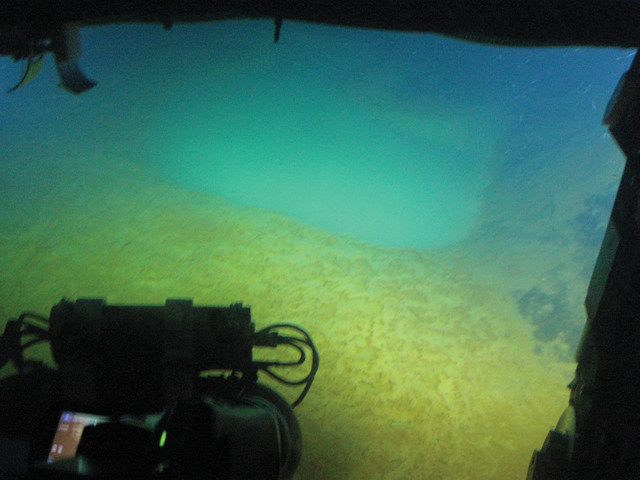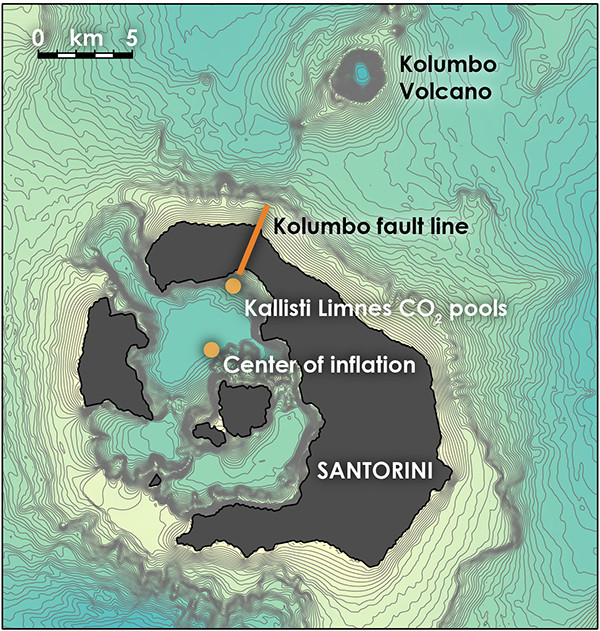
by Mary Caperton Morton Monday, November 2, 2015

Dense carbon dioxide-rich pools on the seafloor near Santorini get their distinctive color from opal particles. The pools may answer questions about deep-sea carbon storage and help scientists monitor the volcano for future eruptions. Credit: Rich Camilli, WHOI.
With its bright blue waters and dramatic cliffside villas, Santorini, Greece, is an idyllic vacation destination, but lurking beneath the Aegean waves lay the remains of one of the most active volcanoes in human history. Because of its eruptive past and proximity to population centers, the Santorini Caldera is closely monitored, but a recent expedition revealed something never before seen there or anywhere else: shimmering opalescent pools of carbon dioxide sequestered on the seafloor.
After erupting cataclysmically in about 1600 B.C., Santorini came to life again 65 years ago, in 1950. And in 2011, swarms of small earthquakes and reports of gaseous odors hinted that the volcano could be reawakening once more. In an effort to monitor the hydrothermal venting occurring in the crater, a team led by Rich Camilli, an engineer at Woods Hole Oceanographic Institution in Massachusetts, sent a series of sophisticated underwater exploration vehicles to explore Santorini’s depths starting in 2012.
Just off the west coast of the island of Santorini, at a depth of 250 meters, the video feed from the submersible revealed what looked like flashes of shimmering whitish-blue water. “When we first got visual on these pools, they were breathtaking, absolutely beautiful. We’d never seen anything like them before,” says Camilli, lead author of the new study, published in Scientific Reports.
The pools ranged in size from 1 to 5 meters in diameter, with some pools interconnected by meandering channels resembling miniature rivers. At first, the team thought the pools might be filled with dense, salty brines. After sending another submersible with a manipulator arm down to sample the pools, they realized the water wasn’t salty, but instead was rich with carbon dioxide, with enough opal particles thrown in to create the whitish hue.
“Brine pools occur when dissolved salt released from geologic formations below the seafloor creates extra density and separates the brine pool from the surrounding seawater,” Camilli says. “In this case, the pools’ increased density isn’t driven by salt. We believe it may be the carbon dioxide itself that makes the water denser and causes it to pool.”
The pools — named the Kallisti Limnes, which means “most beautiful lakes” in Greek — are also about 5 degrees Celsius warmer than the surrounding waters, further hinting at a volcanic origin for the carbon dioxide. “The carbon dioxide seems to be of deep-earth origin and not biogenic, but we still have more tests to run to figure out exactly where it’s coming from,” Camilli says. The gas could be being squeezed out of underlying sediments that are experiencing high heat and pressure, or it could be coming from degassing of the magma chamber itself, he says.
The team isn’t sure how stable the pools are, although the river-like channels carved into the microbial mats at the bottom of the pools hint that the processes that create them may be quite active over time. “The oxbow patterns we see [in the channels] typically take a long time to form, which suggests that the pools may come and go. But they may reappear in the same location with the same flow channels, possibly reoccurring when the volcano becomes more active,” Camilli says.

The Kallisti Limnes and vent mounds are in line with the Kolumbo fault onshore Santorini. Credit: Kat Cantner.
The discovery may have implications for deep-sea carbon sequestration, he says, particularly in regard to the hazards associated with sudden releases of carbon dioxide. Until now, the assumption has been that when carbon dioxide is released into the ocean, it disperses into the surrounding water. But the existence of the Kallisti Limnes suggests that, instead of harmlessly dissipating, the gas could spread over the seafloor, potentially impacting the benthic communities that live there. The risk of sudden releases of suffocating clouds of carbon dioxide — which occurred, for example, at freshwater Lake Nyos in Cameroon in 1986, killing 1,700 people — is low, Camilli notes, due to the buffering nature of seawater, which absorbs more carbon dioxide than a closed freshwater system.
“For those who are proposing to sequester carbon on a big scale by pumping carbon dioxide into the deep ocean, these pools seem to be a unique natural laboratory where nature is doing it on its own,” says Steven Carey, an oceanographer at the University of Rhode Island in Kingston, who was not involved in the new research. “There are things that can be learned by studying pools like this,” Carey says. “How securely is the carbon dioxide locked up in those fluids? Are they ephemeral or long lasting? It’ll be interesting to go back and see how these things behave over the long term.”
Camilli and colleagues are hoping to return to the Kallisti Limnes. “We’ve discussed remotely monitoring these pools,” Camilli says. Such monitoring may help answer some of the questions about the stability of the pools over time, as well as potentially provide new methods for monitoring the activity of Santorini, he says.
© 2008-2021. All rights reserved. Any copying, redistribution or retransmission of any of the contents of this service without the expressed written permission of the American Geosciences Institute is expressly prohibited. Click here for all copyright requests.